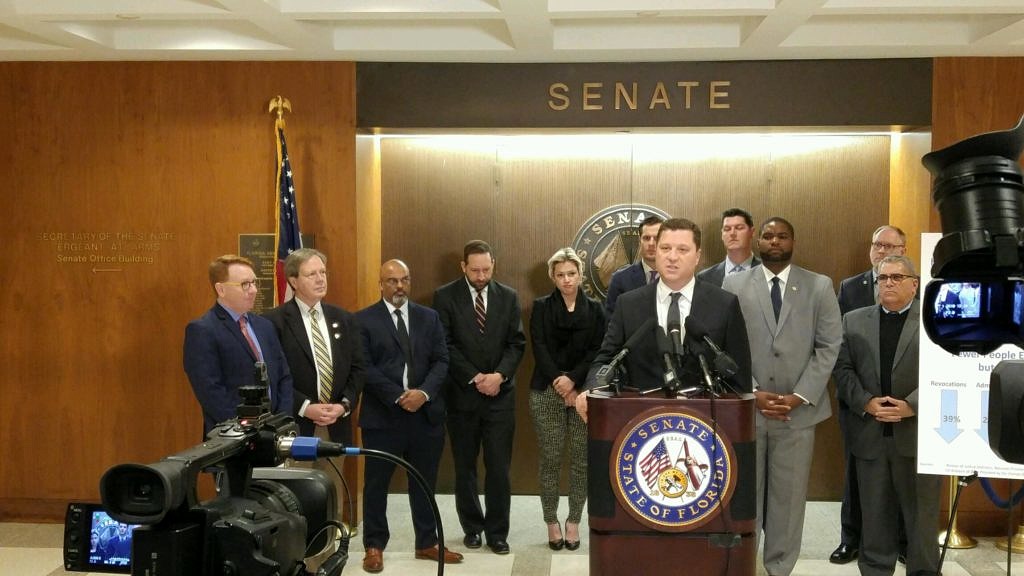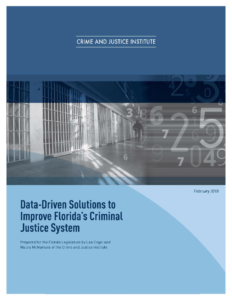
TALLAHASSEE – Florida is sending fewer people to prison, but those who do end up there are serving longer sentences, including individuals convicted of low-level, nonviolent offenses, according to an analysis by the Crime and Justice Institute (CJI).
The prison population has remained static at nearly 100,000 individuals since 2007 as widely applied mandatory minimum sentences and sentencing enhancements have kept individuals incarcerated longer, offsetting reductions in the number of people heading to prison, the analysis found. That gives Florida the third-largest prison population in the country with an incarceration rate 21 percent higher than the national average and costing taxpayers $2.3 billion annually, an increase of $100 million over fiscal year 2014.
Without action by policymakers, the prison population is on track to begin increasing in 2021, resulting in even higher costs for taxpayers.
CJI’s report suggests that by following the lead of states like Texas, Georgia, Utah, and Mississippi, Florida can hold individuals accountable while safely reducing its priso n population without increasing crime through data-driven sentencing reforms, expanding alternatives to incarceration, and implementing policies and practices shown to reduce recidivism.
n population without increasing crime through data-driven sentencing reforms, expanding alternatives to incarceration, and implementing policies and practices shown to reduce recidivism.
“The data show Florida is spending too much money to lock up too many people for too long,” said Len Engel, CJI’s director of policy and campaigns. “We are recommending evidence-based policies that have been proven in other states to reduce their reliance on prison beds, protect public safety, and reduce costs for taxpayers.”
“Florida must cast a bold new vision for the criminal justice system. The policies of the past have created a system that is simply unsustainable, and we must separate and treat differently the people we are mad at as opposed to the people we are truly scared of,” said state Sen. Jeff Brandes, R-St. Petersburg, who is chairman of the Appropriations Subcommittee on Criminal and Civil Justice. “These proposals are a starting point to put us on a path toward reducing our prison population so that we can devote prison beds to those who belong in them – serious, violent offenders – so we can better allocate resources to keeping our streets and our communities safe.”
In early 2017 Florida’s Office of Program Policy Analysis and Government Accountability selected CJI to perform an initial assessment of trends in the state’s prison population. At the conclusion of that assessment, the Florida State Senate contracted CJI to continue examining the state’s criminal justice system, assess other states’ policies, and make recommendations to alleviate strains on Florida’s system.
CJI’s analysis found that in the past decade, Florida experienced a 28 percent decline in prison admissions and a 39 percent reduction in individuals returning to prison for probation violations. But the prison population did not decline as courts handed out longer sentences. Florida’s crime rate, meanwhile, has been steadily declining since the early 1990s.
Several Florida laws dating back to the tough-on-crime era of the 1980s and ’90s have led to the flow of low-level offenders into the prison system and keeping them longer once they’re in. The majority of people going to prison are low-level offenders, CJI’s analysis found. Two-thirds of individuals sent to Florida prisons in 2016 were admitted for a nonviolent offense. And 48 percent of new court commitments in 2016 had no current or prior violent conviction on their record.
The use of mandatory minimum sentences and sentence enhancements has increased 19 percent since 2007, fueling double-digit increases in overall sentence lengths (22 percent) and length of stay (18 percent) for all sentence types, according to CJI’s report.
Florida’s requirement that all offenders serve at least 85 percent of their sentence has created a large incarcerated population with little incentive to get treatment or complete programs. This includes inmates convicted of low-level offenses and elderly inmates, who face limited options for early medical release, even when they are physically incapable of posing a danger to the community.
Recommendations in CJI’s report include:
- Reclassifying felony drug possession as a misdemeanor
- Increasing the felony theft threshold from the current $300, which is among the lowest in the nation
- Expand access to alternatives to incarceration
- Reduce the application of minimum mandatory sentences
- Eliminate the requirement that nonviolent offenders serve at least 85 percent of their sentence
- Implement an early release option for long-term geriatric patients
- Expand eligibility for medical release options to inmates physically incapable of posing a danger to the community
- Revise habitual offender statues to focus the most severe penalties on violent offenders
- Expand the eligibility of inmates to earn time off their sentences for participating in recidivism-reducing programming
- Establish the use of earned credits to allow individuals to shorten the length of their community supervision
- Establish an oversight council to monitor reforms
The recommendations follow the 2017 CJI report, “An Examination of Florida’s Prison Population Trends”.
For more information:
- Data-Driven Solutions to Improve Florida’s Criminal Justice System – February 2018
- Summary of Recommendations – February 2018
- An Examination of Florida’s Prison Population Trends – May 2017